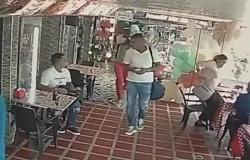The concession for the Western Regiotram will be valid for twenty years after its entry into operation.
Photo: Regional Railway Company of Cundinamarca
In the departments of Boyacá, Cundinamarca, Norte de Santander and Santander the governorates identified in the reactivation of its railway network an opportunity for the development and competitiveness of their territories. The projects in this matter are combined with the works carried out to strengthen tertiary and secondary roads, improve event infrastructure and sanitation and water supply as key elements to guarantee the integrity of its inhabitants.
Your bet is part of a national project that seeks integrate trains again for the transport of cargo and passengers in the country, which directly impacts the economy and the quality of service for citizens. According to data from the Vice Ministry of Infrastructure, By 2023, only 37% of the national railway network was in operationdedicated to the loading of only 11% of the products generated in the country.
Also read: Administrations of the Coffee Region advance health projects with wide impact
However, in cases like that of Boyacá The government promotes the reactivation of this transportation system through the medium speed train project, one of the most ambitious of the administration. Seeks connect to Boyacá and Bogotá, with stops in the municipalities of Duitama, Paipa and Tunja, to strengthen trade and tourism. In January 2024, the National Infrastructure Agency (ANI) and the department signed an inter-administrative agreement to advance its pre-feasibility.
He Governor Carlos Amaya, president of the National Federation of Departments (FND)pointed out that “it is vital to work for a medium-speed train, which is electric and allows easy communication between the country’s capital and Boyacá; “This is going to make us become a dormitory apartment.” He explained that At least 2.5 million Boyacenses live in Bogotá who could live in Boyacá and transport themselves quickly and safely in this system, contributing to the economic development of both places.
For your part Leonardo Álvarez, Secretary of Infrastructure of the departmentHe added that the project seeks to “bring Boyacá closer, generating great tourist and economic growth. This commitment allows development with the National Government’s focus on rescuing the railway network and allows modernize and update ourselves to the big economies”. He pointed out that they hope to finish phase one, corresponding to pre-feasibility, in October 2024, which would result in At the end of 2025, phases two and three, of technical development and budget, will be completedto start later with the search for resources.
Added to this project is the purpose of “carry out the seven ways of the Bicentennial Pact and sign a new pact with the National Government that allows us to strengthen the corridors that connect us as a region,” said Amaya. Among these projects are the Villa Pinzón – Turmequé – Tibaná road, the Tibaná – Chinavita – Garagoa – Las Juntas highway and the communication routes with Cocuy. In total they are at least 67 road corridors which they hope to keep in the best conditions.
Boyacá has a total of 9,348 kilometers of roads.
Photo: Governorate of Boyacá
In Cundinamarcawith the advances of Regiotram of the West, it also seeks to make communication between Bogotá and the municipalities of La Sabana more effective. This project hopes mobilize at least 130,000 passengers daily between Facatativá and Bogotáin a forty-kilometer railway corridor that will also connect the municipalities of Funza, Mosquera and Madrid.
For its construction, whose estimated cost is $3.6 billionthe nation will provide 69% of the resources and the Government of Cundinamarca will provide 31% remaining. This project will be 100% electric and is expected to be connected to the first line of the Bogotá Metro on Calle 26 and Avenida Caracas. At the moment The construction of the workshop patio in the Corzo sector (Facatativá) is underway with an advance of 13%. The Government of Cundinamarca hopes to begin work on the railway corridor soon, so that the 18-train system comes into operation around 2026.
The recent announcement by the Ministry of the Environment about the exemption of the environmental license for railway projects based on alternative energies gave new impetus that expedites this initiative. In this regard, the Governor Jorge Rey He assured that the decision “will allow the train works to continue; You will see the constructive development of the main central railway networkalong with the seasons.”
Furthermore, he clarified that the Regiotram de Oeste does comply with environmental requirementsonly that “we will limit ourselves to the PAGA environmental guide, where each environmental procedure will be managed before the corresponding territorial authority.”
You may be interested in: Women lead the construction of peace and the development of the countryside in the South of the country
Orlando Santiago Cely, manager of the Cundinamarca Regional Railway Companyexpressed that this “mobility solution for the West of Bogotá has an efficient use of travel times, reducing them from three hours to about one hour between Facatativá and the center of Bogotá; It is a high-tech trainwhich uses an existing rail corridor and a sustainable project that gives great benefits by achieving a reduction in the number of CO2 emissions close to 165,000 tons”. The progress of the works is combined with the construction of a citizen culture scheme called “Royal Culture”with which they hope to achieve good use and appropriation of the system by people.
However, this is not the only project regarding connectivity. Yesenia Herreño, manager of the Institute of Infrastructure and Concessions of Cundinamarca (ICCU)highlighted several road projects, including the Veredal Roads Fund, which has between $700,000 million and one billion pesos to develop works of intervention in road networks, also linking the community action boards. The official also highlighted the importance of “teamwork with Bogotá to advance projects, studies and designs (…) since everything is related between the department and the capital.”
The Western Regiotram reduces the connection section between the center of Bogotá and the municipalities of the Western Sabana to one hour.
Photo: Regional Railway Company – Government of Cundinamarca
In line with the modernization of rail transport in the Central region Feasibility studies for the Catatumbo Train are under developmentwhich seeks to connect to North of Santander with the Caribbean, promoting agriculture and tourism. The feasibility study was awarded for more than $7.36 billion and within a period of fifty weeks the technical, economic, environmental and social aspects of the work must be defined, for which there are two possible routes; both starting from Cúcuta and arriving to Gamarra (Cesar) or Santa Marta (Magdalena).
He governor of Norte de Santander, William Villamizar, expressed that “the objective is to take cargo to the Caribbean Sea; We are attentive to its development because This train is needed by the region”. It is expected that 2.62 million tons of products such as cereals, ceramics, cement, steel and metals will be moved through this line.
Marcela Angulo, Secretary of Planning and Territorial Development of the departmentreaffirmed that this project, which is part of the National Development Plan, responds to “the idea that we can produce our products, especially in what we are strong in, such as palm and coal. The geography of Norte de Santander is quite irregular and this allows us connect more quickly with Caribbean ports”.
However, this is not the only infrastructure project, since connectivity is complemented by thecommitted to making the border department a key site for the development of high-impact events in the country. Following this objective, the projects of the Center for Events, Exhibitions and Innovation (CEEI), which already has the resources for the works to begin in less than a month. Also the new Convention Center in Villa del Rosariofor which the department has just received a contribution of $16 billion from FONTUR to complete your financing.
The official highlighted that “departments like ours We are committed to opening borders for the development of Norte de Santander and from that large region that includes Táchira (Venezuela), which do not have services such as convention and exhibition centers where Venezuelan and northern Santander entrepreneurs can come together in a single space for innovation”.
Governor Villamizar added regarding these works that his objective is “to bring events of national and international stature to this region, an important commitment that will benefit unions, economic sectors and citizens”.
Progress in the construction of the workshop yard of the Western Regiotram, in Facatativá.
Photo: Regional Railway Company of Cundinamarca
In Santanderalthough there is no project of its own to reactivate trains, the Governor Juvenal Díaz He expressed that “the backbone of the railway network is the La Dorada-Chiriguaná route, which passes through Santander.” In that sense, the nation advances in the study of connection of the department with the railway network in Duitamawhich would complete the regional reactivation of the system.
However, the strength of the investment there is the intervention of roads. Among the projects that the president mentioned, Bucaramanga stands out “the external ring road, which is necessary to unclog the metropolitan area (…), our great challenge is to finish it and expand it to a dual carriageway, for which $544 billion “What we are going to achieve through valuation.”
Added to the above is the project of the dual carriageway between Rionegro and Bucaramanga, for which “we continue to seek agreements with the communities that allow us to find financial closure.” Also the dual carriageway and the construction of overtaking lanes on the road that leads from Bucaramanga to Barbosaas well as the construction of the Curos-Málaga roadfor which “we managed to convince the president to implement the financial model of bringing future validity at present value and thus be able to advance significantly,” said the president.
The departmental projects are added to the “joint work with the governors of neighboring departments to solve regional problems like the Bucaramanga-Pamplona road.” But that is not the only issue on which Governor Díaz called for regional and national coordination; He also highlighted others such as “security together with Antioquia and Bolívar, we have had conversations with Boyacá for the maquila of our new departmental liquors and hWe have analyzed profound environmental issues that concern us all”.
Also read: Inhabitants of the Pacific seek progress through agriculture and road development
In that way, the connectivity of the Central region of the countryas well as the joint approach to highly relevant topics such as water management and protection of moorsare part of the coordination efforts of the four departments, whose impact is not only regional but also national on issues such as water supply and the logistics and commercial connection beyond the border national.
*This is content developed within the framework of the Building Regions of Progress initiative, of the National Federation of Departments, and supported by El Espectador.






